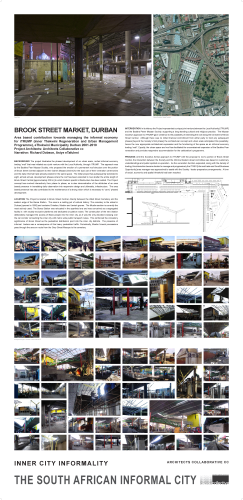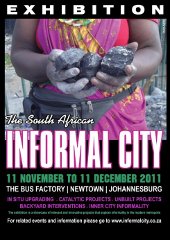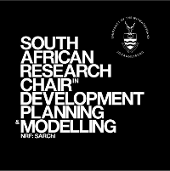You are here
INNER CITY INFORMALITY
Below is a brief excerpt from each of the projects in this category. Click on the links or image to see the full project panel details and illustrations.
Brook Street Market
Exhibitor: Architects Collaborative cc
The project illustrates the phased development of an urban scale, roofed informal economy trading “mall” that was initiated as a joint venture with the Local Authority, through iTRUMP. The approach was by the Badsha Peer Mazaar Society, who proposed the erection of a permanent roof structure over the portion of Brook Street Central adjacent to their Saint’s Mazaar [shrine] for the dual use of their veneration ceremonies and the daily informal trade already existent in the same space. The initial project has subsequently extended to eight, almost annual, development phases where the roof has been extended to now shelter the entire length of Brook Street Central [approximately 200 m] to which traders’ specific infrastructure has been added. The Project concept has evolved interactively from phase to phase, so is also demonstrative of the attributes of an area based presence in translating daily observation into responsive design and ultimately, infrastructure. The area based presence has also contributed to the maintenance of a strong vision which is necessary to “carry” phased development.
Ekhaya Neighbourhood Project & Upgrades of Existing Buildings
Exhibitor: Savage + Dodd Architects
In 2002, Savage+Dodd Architects undertook a first upgrade of a so-called 'bad building' in Hillbrow for the Johannesburg Housing Company (JHC). Our involvement architecturally was quite limited. Bad buildings are those which have become degraded through lack of maintenance and service provision over years, most have absentee landlords and have been hijacked or been invaded by illegal tenants. Since then we have undertaken many projects of this nature and our involvement has become more intense.
Inner City Movement Framework
Exhibitor: Monica Albonico and Lone Poulsen
The city is an amalgamation of complex layers of people, trade, movement, ever changing requirements and functions, the formal and the informal. All these layers are overlapped and entangled, making them, at times, indistinguishable from one another.
At the core of the city are its networks. These complex connections are played out on the canvas of the modernist city grid, structuring sets of relations, defining the activities and interactions between the formal and informal and shaping the "ordinary", everyday contested spaces.
Jeppe: The Chaos Precinct
Exhibitor: Dr Tanya Zack and Robyn Arnot
Urbanisls who have encountered the area of the city centre roughly bounded by Van Weilligh, Pritchard, Troye and Bree Streets have coined various names for it: The Ethiopian Quarter, Little Ethiopia and Little Addis references 'otherness' and emphasises the association of the area with an 'away' place - an exolicising of our city. Bul no formal planning framework addresses this area's land use as distinctive in the central business district. In fact municipal officials speak informally of the area as the CHAOS PRECINCT.
Recycle Change
Exhibitor: Tanya Zack/ Sarah Charlton/ Bronwyn Kotzen
Nobody wonders where each day they carry their load of refuse, outside the city surely: but each year the city expands...The bulk of the outflow increases and the piles rise higher, become stratified, extend over a wider perimeter.
The label 'homeless' is often applied in a largely undifferentiated manner 10 a wide spectrum of living circumstances. These conditions are often assumed to result from particular personal and most often, economic circumstances. The limitations of this conflation of living conditions with personal circumstances are shown in the lives of informal recyclers in Johannesburg.
Warwick Bridge
Exhibitor: designworkshop : sa
By 1996, when the project was commissioned, the main Railway Station had long been moved from the center of the City to the Warwick Triangle area at it’s western edge. Black commuters were the primary commuter rail users and, under apartheid, the motivation was to remove them from the city.
The consequence was that the area around the station rapidly became a hub of commercial activity, primarily
trading from the city sidewalks, public open spaces, and any other viable location where there was opportunity to do so. Trading was unstructured and unregulated and rapid growth put infrastructural services under pressure for which they were not designed.
Powered by AA Media and The Architects Collective of South Africa






